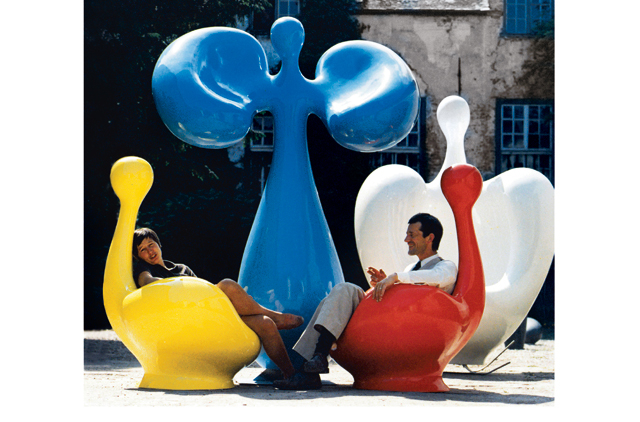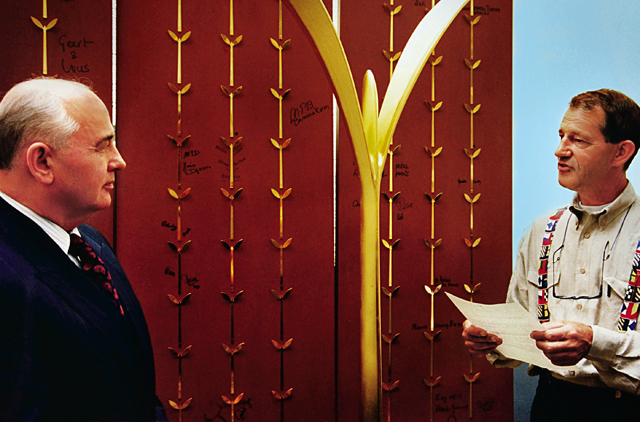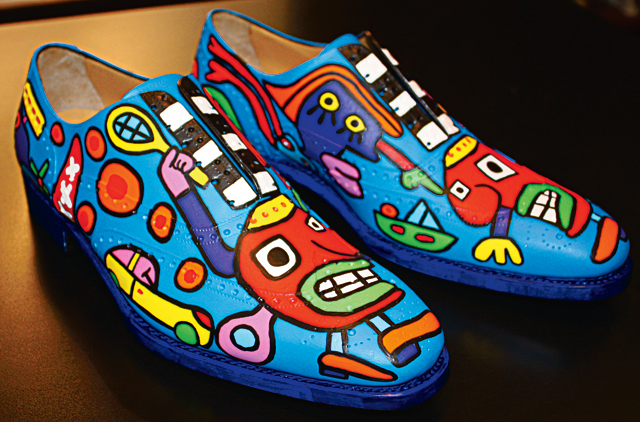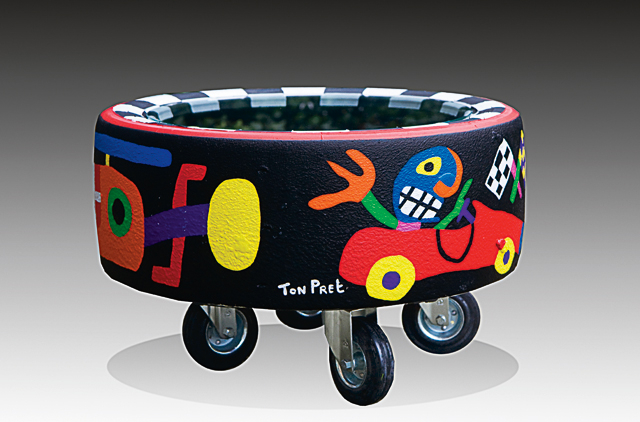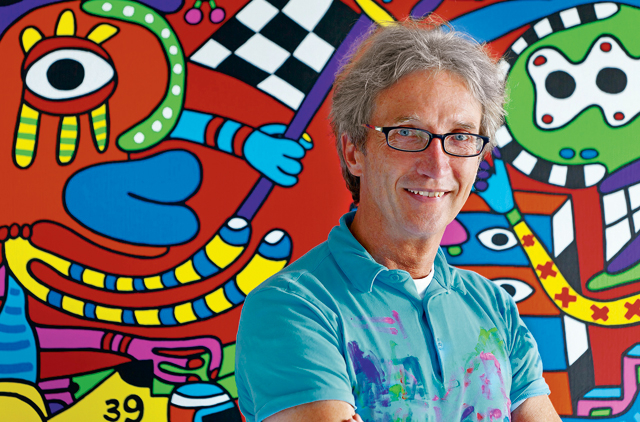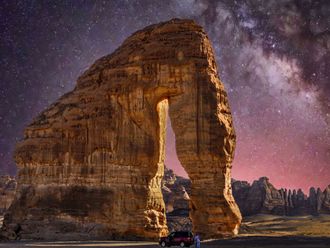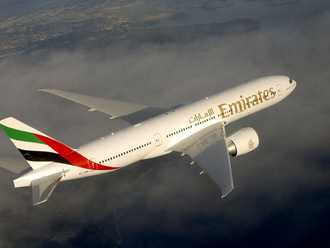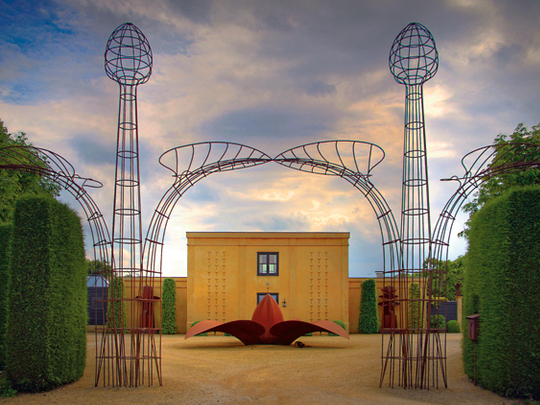
I like to believe that art is in the veins of every Dutch person. No matter which part of the country you hail from, art is a vivid, tangible presence.
In The Netherlands, art has shaped us through the ages, from the 15th century to where we are at present. Who has not heard of Vermeer, Frans Hals, Rembrandt and van Gogh, or recent names such as Karel Appel and Verkerk?
Among current artists, one whose work influenced me during my days as an art student in the Netherlands was the creator of what I would describe as an angelic chair — a fluid, sculptural piece of functional art. The form, which I since discovered dates to 1970, intrigued me at the time and has inspired me through the years. Decades later, as I visited the annual Art Dubai fair, my attention was drawn to a pair of walking sticks with golden knobs, the design resembling the iconic chair so vivid in my memory.
Two people walked around the room peering at the art on display; they were an artist couple, Adelheid and Huub Kortekaas, and as it turned out, the very creators of that iconic chair.
Over the course of a strong friendship that we since built up, I learnt that there was an entire philosophy behind what they called the Angel Heart Chair. I was fortunate to discover this philosophy on a visit to their homestead in the Dutch village of Winssen, outside the city of Nijmegen. Their home, the Tempelhof, which could be translated to mean ‘the area of the temples’, is now a symbolic feature of their combined philosophy of Quantum Art.
To the onlooker, their work is spiritual and forces introspection.
Bridging the divide
Huub has described himself as being like a quantum physician, looking for insight into the fundamental principles of creation. The couple seek not to present themselves as artists, but as alchemists looking for the symbiosis between economy and spirituality.
There’s a deeper, political message here: the Kortekaases’ desire to combine the five major religions into a single unifying force. This philosophy is evident at the Tempelhof, from the sequence of numbers behind each individual structure to a meticulously laid out ‘spiritual garden’, the latter that the pair consider to be their most remarkable project to date.
“These gardens represent the five world religions as ‘poetic flowers’ of the all-embracing cosmic consciousness,” Huub says. “In the last, sixth garden arises the Temple of Universal Spirituality. In this open temple, the five world religions merge to become a monumental flower as the symbiosis of human spirituality.”
The pair are presently engaged in an ambitious global project. Called the Acre of Peace, it comprises 990 small gilded seedlings and ten larger gold-plated plants, each 2.2 metres high and symbolic of mankind’s spiritual dimensions.
“These ten Golden Plants are only offered to special humanitarian and personal initiatives that promote a positive change in the climate of life,” says Adelheid. Thus far, four plants have been given away. One was presented to Mikhail Gorbachev, former Soviet president and Chairman of the International Green Cross, and another to a pair of Yanomami Indian shamans.
Next year, chat show queen Oprah Winfrey will be given another plant, “as a symbol of the worldwide emerging female energy of millions of unknown strong women who commit themselves to improving their daily reality.”
And next month-end, former South African president Nelson Mandela will also be honoured with a golden plant, in recognition for his persistent struggle against apartheid and his commitment to world peace. The plant will stand outside South Africa’s Drakenstein Correctional Centre, where Mandela spent the last three years of his 27-year incarceration.
But how do two people create art together? Huub is the philosopher, while Adelheid, with her unlimited fantasy and passion for architecture, fulfils the role of complementing and being an integral part of the dream, they tell me.
The couple’s most expensive work to date is the Anima Mundi — a conceptual artwork 99 metres long, 12 metres wide and 6.66 metres high. It is inspired by an ancient Greek agora, or assembly square, and is being realised close to the Tempelhof.
“It will take 2.5 years before the project is completed,” says Adelheid. Estimated cost? Around €5.5 million (about Dh27.5 million).
“The Anima Mundi art project represents the turning point in Western materialistic thinking. It is an expression of the zeitgeist in which man is becoming aware that he is a co-creator of this world and of the responsibility that this new awareness brings with it,” says Huub.
That’s right in line with Dutch thinking: if god created the earth, the Dutch created Holland, goes the old saying, since a large part of the country lies below sea level and its landmass is constantly being reclaimed and added to. Which, in a sense, makes the Netherlands a piece of art.
— The author is a design strategist based in the UAE. He can be reached at hink@imagecreatorsme.com
MIX AND MATCH
I first noticed Ton Pret’s work on a social media page. It reminded me instantly of Karel Appel, one of the founders of the avant-garde Cobra movement of the ‘50s and ‘60s. Therefore, I simply had to ‘like’ him and remained in touch with him.
Like the Kortekaases, Pret has had no formal education either and is driven by a deep passion for art. While the latter’s oeuvre includes “wearable art”, the former produce as part of their philosophy what can best be described as “liveable art”.
Pret’s work is characterised by bright colours and strong playful imagery that he uses to reach the child within each of us. He has had his work exhibited in Amsterdam’s Rijksmuseum, and through private collections in Asia, America, Australia and the Middle East.
Pret didn’t set out to become an artist. After having run a successful financial services business for 20 years — and made plenty of money in the process — he lost his passion for finance.
He says, “It was my dream to become an artist, despite the fact that I had no formal art education, but simply enjoyed drawing as a child. That creative feeling and desire came back to the fore and I decided to sell my company and become an artist. I bought a canvas, painted it in my own style and went to an art gallery, who after viewing my art, immediately offered me a contract, and the painting was sold in no time.”
He has since put his signature characters on shoes, jeans, jackets, watches and furniture — all sought after by collectors and celebrities — but his most important project was turning a Ferrari 355GTS into a piece of art.
“I worked on the project for seven weeks in the Ferrari workshop in the Netherlands. A real challenge and extremely exciting this was,” he says. “The price tag was estimated to be more than €100,000 (about Dh500,458).”
It’s hard to pin a definition on him, however. He refuses to categorise himself as painter, sculptor or designer. “Really, I am a cocktail, a mix if you like of all three and you clearly see this back in my objects as I simply let all elements melt together.”
Although his work has commercial applications, he does not see himself as a commercial artist. “I see myself as a ‘pure artist’ and have never been driven by money, no, my drive came from creating art in total freedom. It is true of course that commerce discovered me and I see this only as a positive evolvement as through this my art can spread beyond pre-defined borders. I will remain creating art in my own world, free from external influences.”
Going forward, he has a lot on his plate. 2012, he says, will see the realisation of some impressive plans. “Not only will an important fashion brand feature a special Ton Pret collection, but I will be working on two large international projects as well. Although I’m not allowed to disclose anything yet, I can tell you they definitely will attract a lot of attention.
“And on the home-interiors front, you will witness some special creations. Who knows, my art might soon be available in the UAE as my aim is to spread my art across the world with everyone saying, ‘I have a Ton Pret on the wall.’”


